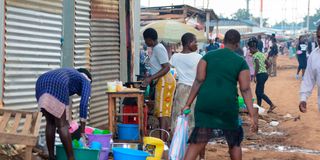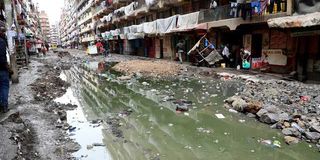Why fight against cholera is still far from over, decades later

Makeshift hotels operating in unsanitary conditions at Kibuye Market, Kisumu County on May 7. This is despite a closure order by the county government over cholera outbreak fears.
What you need to know:
- Frequent outbreaks of the waterborne disease have exposed failures in the public health system, with the crisis showing why the government must address inequalities in accessing clean water and sanitation facilities.
At the break of dawn in Nairobi’s Kibra, women haul jerricans of water, children trail behind them barefoot, and street vendors begin their daily routine.
But behind this ordinary hustle and bustle lies an extraordinary crisis, one that Kenya has been fighting for decades. Cholera, a waterborne disease eradicated in many parts of the world, continues to claim lives in the country.
A few weeks ago, the Ministry of Health confirmed more than 100 new cholera cases and 13 deaths in Nairobi, Kisumu and Migori. Behind these numbers are stories of poverty, neglect, and a broken public health system.

Kenya has so far recorded 100 cases cholera in the latest outbreak.
In Soweto East, one of the most densely populated slums in the country, 38-year-old Jackline Achieng lives in a tin shack with her three children. The room serves as a bedroom, kitchen, and living space. There is no toilet. Like many of her neighbours, Jackline and her children rely on plastic bags, commonly known in local slang as “flying toilets” or “juala”.
“You do your business in a bag, tie it, and throw it out at night,” she says. “Where else can you go?”
The nearest latrine is shared by more than 50 people and is a 10-minute walk from her house past rows of iron-sheet kiosks selling food, plastic goods, and shoes. It costs Sh10 per use. Jackline cannot afford to pay that every day.
Meanwhile, wastewater flows openly, carrying feaces, trash, and disease. Nearby, a woman fries mandazis—unshielded from the filth.
“We have no choice,” she says. “People need to eat.”
Cholera is spread through contaminated food and water. The Vibrio cholerae bacteria that cause it survive in places with poor sanitation and limited access to clean drinking water. Kibra, sadly, checks all the boxes.
Symptoms include sudden onset of severe watery diarrhoea, vomiting, muscle cramps, and severe dehydration, often appearing within two hours to five days after infection.
It is a serious disease that can lead to rapid dehydration and potentially death if left untreated. Prompt medical attention is therefore important for persons suspected to be infected with cholera.
The infection is severe during rainy seasons when surface runoffs find themselves into water bodies.
Only 20 per cent of Nairobi’s informal settlement residents have access to piped water. The rest rely on vendors or collect water from unsafe sources. During dry seasons, the situation worsens as water becomes scarce and prices shoot up. At times when it rains, water mixes with faeces.
“Clean water is sold like a luxury here,” says Achieng. She pays Sh50 per 20-litre jerrican of water, which is barely enough for drinking and cooking, let alone washing hands or maintaining hygiene.
Kenya’s cholera crisis is deeply tied to water shortages, inadequate sanitation infrastructure, and poor hygiene practices, particularly in rural areas and informal settlements. The lack of toilets forces open defecation, contaminating water sources and soil, while water scarcity means even the available supplies are often unsafe.

Stagnant dirty water and garbage on a road within Pipeline estate in Nairobi.
In the wake of the cholera outbreak, the Ministry of Health has urged the installation of accessible handwashing stations in public areas – well equipped with clean water and soap, or hand sanitisers containing at least 60 per cent alcohol to ensure effectiveness.
“Drink only clean water (boiled or chlorinated), avoid untreated water from open sources like rivers and lakes, store water in clean, covered containers and dispose of waste properly to avoid water contamination. Also, avoid open defecation and maintain clean, functional latrines; and regularly disinfect surfaces, especially those used for food preparation. Wash hands and sanitise surfaces and utensils before preparing food,” said the ministry statement.
However, what the ministry is advising is not applicable since a majority of those affected do not have access to clean water and sanitation is mostly poor since they cannot access toilets.
Dr Maurice Nyongesa, a public health expert, said Kenya recording cases every other time is frustrating especially because cholera is one of the most preventable diseases.
“All you need is clean water, proper sanitation, and good hygiene,” he said. “Yet we’re still dealing with outbreaks in 2025. Why? Because of systemic neglect. The problem isn’t medical. It’s political.”
The government has launched various initiatives over the years such as cholera control plans, water sanitation drives and public awareness campaigns. Yet none seems to have a lasting impact.
“A lot of these plans remain on paper,” Dr Nyongesa added. “Implementation is poor. Corruption is rampant. And yet informal settlements like Kibra are at the bottom of every budget line.”
Ironically, Kenya is not short of innovations. In Kisumu County, a public-private initiative is providing chlorinated water kiosks in informal settlements. In Mombasa, bio-centres are offering pay-as-you-go toilets and showers. But scaling up such models requires political goodwill and funding.
Dr Nyongesa believes that the country needs a national cholera control strategy that specifically targets high-risk areas, especially informal settlements. “We can’t rely on emergency response forever,” he says. “We need preventive action.”
Public health officials say personal responsibility alone won’t fix the problem. Cholera is a systemic issue. They say that unless Kenya invests in clean water and sanitation for all, especially in its poorest communities, the disease will remain a deadly companion.
And in the alleys of Kibra and other informal settlements, children will continue to play near open sewers, mothers will cook beside piles of garbage, and families will mourn loved ones who died of something as preventable as cholera.
Dr Samuel Kariuki, a chief research scientist and director at the Centre for Microbiology Research at the Kenya Medical Research Institute, had earlier indicated in an interview with Gavi that eradicating cholera is all about resources.
“Oral cholera vaccines save many lives each year worldwide, but making populations safe from the waterborne bacterium's brutal onslaught is a matter of access to clean water and sanitation. "It's all about resources.
"HIV, tuberculosis and malaria have established systems for surveillance and secured funding. At the ministry, there are programmes for these big diseases. But the same is lacking for cholera,” said Dr Kariuki.
Last week, a family in Kisumu lost a three-year-old child to cholera. They had just retired to bed when the child developed fever, started vomiting and diarrhoeaing.
The baby was rushed to Ahero Sub-county Hospital, where he was diagnosed with cholera.
While conducting contact tracing, health workers found the other two siblings in a critical condition and had them admitted to Ahero Sub-county Hospital.
Most cholera deaths occur within the first 24 hours of symptoms. This is often because people don't recognise the signs and symptoms or have limited access to medical care.
According to Daniel Owino, a Community Health Promoter (CHP) from Nyando Sub-county, the three-year-old baby died a couple of hours after admission due to complications arising from the waterborne disease.
"By the end of the day, the entire family had been hospitalised, including the father, who had to be fetched from his work station. He also admitted that he was already experiencing cholera-like symptoms.”
The CHP said they later came to learn that the family had been using untreated stagnated water, exposing them to the disease.
The family was also yet to put up a pit latrine after the facility they previously used collapsed amid heavy rains.
"Putting up a latrine in this area remains one of the biggest challenges. During heavy rains, the facilities are either flooded or collapse, emptying their contents into water streams while posing a health risk.”
He added: “Very few people put up latrines once the rains subside, resorting to open defecation.”
This, however, is not the first case of cholera in his village.
Towards the end of March, a mother and her 14-year-old daughter succumbed to complications arising from cholera. The young girl had gone to visit her sick mother when she started vomiting and diarrhoeaing.
By the time the two got admitted to the nearest health facility, their health had deteriorated.
"One of the biggest challenges we have is poor access to clean water. Many villagers use stagnated water for domestic purposes unaware of the dangers they expose themselves to,” said Mr Owino, whose community unit is among the areas affected by cholera . At the nearby Kakola Ombaka location, assistant chief Neto Awich said they have reported three cases of cholera.
While one of the patients was hospitalised after returning home from a burial outside the county, one other case is of an individual who was diagnosed after visiting a sick relative at Nyando Sub-county Hospital.
“We suspect the remaining case could be a result of open cooking, which is practised by many hotels within the location," he said.
According to the county’s health reports, seven people have succumbed to complications arising from cholera since the first case was reported earlier this year.
Kisumu County has also reported 85 cases of cholera, with 77 having been successfully treated and discharged; while one more is still in isolation.
In a public notice issued on the evening of April 25, city manager Abala Wanga said the Health department raised concerns over sanitation in Kibuye market, which he said posed a serious threat to the health of traders.
The Health department identified a number of sanitation threats in the market, including the lack of clean and safe water, improper solid waste management, unsanitary ablution and toilets, open and unsafe cooking facilities and blocked a drainage system.
“These conditions pose an imminent risk to public health, especially during the rainy season when waterborne disease transmission is heightened,” said Mr Wanga.
According to Kisumu County Director of Public Health, Fred Oluoch, the market did not have a sewerage section while the drainages had been blocked by debris since traders had built structures over them.
In Homa Bay, the stench hits before the sight does. It is common to come across raw sewage flowing freely in some residential areas. Sometimes sewage would flow for days before the county government took action.
In most cases, repairs of broken sewer lines in affected areas would only solve the problem for a few weeks before residents went back to the same environment.
In Shauri Yako, an informal settlement in Homa Bay town, some areas have dilapidated manholes that discharge human waste, which mixes with water.
Here, children play near open sewers or broken manholes, unaware of the lurking danger.
Ms Pamela Otieno, a resident of Shauri Yako, said poor sanitation within the informal settlement is a recipe for a cholera outbreak.
The 20 people who live within the compound where she stays share two toilets.
"Sometimes the toilet gets clogged and we are forced to use one that is in a neighbouring compound," Ms Otieno said.
Public Health Chief Officer Evelyn Ododa said health workers are on the lookout for cholera and other illnesses associated with the use of contaminated water.
“We have taken all precautionary measures to ensure the region does not record cholera cases. Residents should also support our efforts by maintaining high health standards to avoid any chances of contracting the disease,” she said.
Ms Ododa said hand washing with soap and running water is one of the most effective ways of fighting the disease.
Dr Luokoye Atwoli, Dean at Aga Khan University Medical College, East Africa, had earlier indicated that the cholera outbreak is a sign that waste disposal system is not up to scratch, hence human waste is mixing with water and food.
“In public health, a cholera epidemic says a lot about an organisation and the effectiveness of the health system than any sophisticated monitoring and evaluation assessment could uncover,” Dr Atwoli said.
“In a modern, open and democratic society such as we aspire to become, citizens should not countenance any excuses for repeated epidemics of a disease that can only be transmitted through the mixture of human waste and drinking water.”
He said the government seems to have given up on healthy lives and is content to just get by.
A study published in the Tropical Medicine and Hygiene Journal last week, titled ‘Spatio-temporal pattern and risk factors associated with cholera outbreaks in selected high-risk areas of Kenya’, revealed that cholera cases varied spatially by year.
“The peak of the cholera outbreak occurred in 2015, affecting 21 sub-counties. There was another peak of cholera cases in 2022, affecting only three sub-counties. These were attributed to prolonged rainfall and subsequent flooding, which led to contamination of water sources and the rapid spread of cholera. The outbreak in 2022 was triggered by the impact of prolonged and severe drought, which resulted in water scarcity.
“Inadequate access to clean drinking water and poor sanitation exacerbated cholera transmission. Poor sanitation was also identified as a risk factor for cholera outbreaks,” says the study.
The study was conducted in Mukuru, an informal settlement in Nairobi; counties bordering Lake Victoria (Kisumu, Siaya, Migori and Homa Bay) and the Dadaab refugee camp.
“Unimproved sanitation systems were shown to pose a higher risk for cholera outbreaks. This included households with open defecation, bucket latrines and open sewage systems. Faecal material may overflow and discharge directly into the environment, leading to increased risk of disease via the oral–faecal route,” says the study.
Dadaab and Fafi stood out as areas of extremely high priority, with persistent cholera cases.
“Community education on cholera prevention measures and promotion of community-led hygiene and sanitation initiatives is crucial. Prioritise investment in water and sanitation infrastructure in Dadaab and Fafi sub-counties and provide periodic surveillance and continuous improvement of Water, Sanitation, and Hygiene facilities in counties bordering the Lake Victoria region,” recommends the study.



